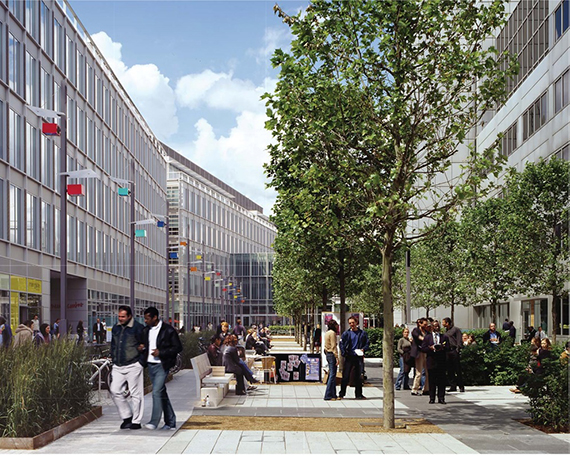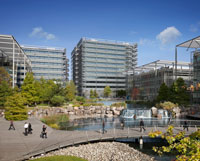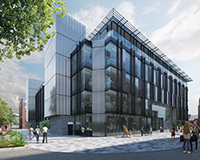
East London has become a formidable magnet for tech and media occupiers. Markets such as Shoreditch and Clerkenwell have created a brand that has appealed to young creative businesses, drawn not only to affordable rents, but also to the opportunity to cluster in cool spaces that offer a refreshing alternative to bland corporate office blocks.
Yet however novel its offer might appear, the east has in many ways followed the lead given by markets on the opposite side of the city. While the east has grabbed the headlines, the west has quietly got on with providing a home for some of London’s most established TMT occupiers.
From record labels to broadcasters, production companies to software developers, west London is a hive of creative talent and has helped trail-blaze today’s occupational trends.
“In the late 1990s and early 2000s, when Silicon Roundabout was just plain old Old Street roundabout, west London already had cool warehouse-style office campuses for creative people,” says Justin Clack, partner at west London agent Frost Meadowcroft.
According to Clack, the likes of Westbourne Studios and Great Western Studios set the tone for the type of cool, collaborative working environments that are now so sought after.
At the same time as providing space for small, growing businesses, the west has also created a hub for bigger space users and still accommodates major names such as Sky, Virgin, Intermediate Media and the Discovery Channel.
David Cuthbert, partner at Hanover Green, says: “With occupational costs half of those in central London and the availability of big floorplates, that trend is only going to continue.”
Cuthbert says many of those working in tech and media businesses in the east commute from the west and if west London was seen to offer a viable alternative, many would prefer to work closer to home.
“It will be interesting to see what happens to businesses in the likes of Shoreditch that have grown from employing three or four people to 40,” says Cuthbert. “If there isn’t the space to accommodate them, will they jump across to the west?”
As London occupiers become more footloose, west London’s development pipeline could offer a significant advantage.
Over the past 15 years, Chiswick Park has been a hub for some of London’s most established media and tech occupiers, including Disney, Paramount and the Discovery Channel. The 334,000 sq ft Building 7, the last on the site, is currently being fitted out.

“We’ve now got 12 large media companies on site and expect the new building will also attract interest from the sector,” says Chiswick Park’s Gemma McNeilis. “They like the opportunity of being able to network and attend events with similar businesses.”
Over in White City, another creative hub is appearing. As well as converting the BBC’s Television Centre on Wood Lane into a mixed-use scheme, developer Stanhope is creating a new commercial core, branded White City Place. The BBC will retain three of its buildings; the other three – White City One, Media Centre and Garden House – are being refurbished and brought back to the market from 2016.
Ultimately, the plan is to deliver about 785,000 sq ft of commercial space up to 2018. “It’s early days, but we’re already attracting interest from tech, media and fashion occupiers, including two or three occupiers in the east looking to relocate,” says Knight Frank’s Ian McCarter.
Stanhope is well aware that, given the war for talent, the buildings will have to fire the imagination. “It’s not about conventional white boxes,” says McCarter. “Occupiers want creative space with interesting finishes, double-height receptions and cool restaurants, all set within a 24/7 environment that has a real buzz.”
That focus on design will prove critical if the west is to attract more creative occupiers, many of whom may still regard the area as being too bland and corporate.
Dan Hanmer, head of the creative London team at CBRE, says: “Occupiers in the east like the trendy warehouse and industrial vibe, but if you can produce that feel elsewhere and get a couple of sweetheart deals, you might see a herd mentality.”
Hanmer points to rising rents across the east, nearing £60 per sq ft in Shoreditch, while some deals in Clerkenwell have hit £70 per sq ft. By contrast, rents in Hammersmith stand at about £50 per sq ft and, after a period of tight supply, there is now huge appetite from developers to deliver quality stock.
Most development has focused on Hammersmith, where JLL says about 675,000 sq ft of office space is likely to be delivered over the next three years. Much of this space is targeting occupiers demanding the type of inspiring workspaces that have proved so successful in the east.
Hanmer highlights Westbrook Properties’ Aircraft Factory. The 73,000 sq ft former factory, once home to the Alliance Aeroplane Company, is being refurbished to provide a campus office environment. It will offer incubator units from around 800 sq ft, plus a range of space options to appeal to tech and media occupiers.
Also in Hammersmith, AXA Real Estate has launched its three-acre urban campus, Assembly London, on the site of the former HarperCollins offices.
The first phase, due for completion in December 2016, will comprise two buildings delivering 150,000 sq ft of office space and 20,000 sq ft of retail and leisure. AXA is in talks with a couple of tech businesses and is about to agree a 30,000 sq ft letting to a TV production company.
Elsewhere, Landid and Brockton Capital have just launched the 83,000 sq ft refurbishment of former Coca-Cola space at One Queen Caroline Street, and in early 2016 Development Securities and Aberdeen Property Trust will complete a 167,000 sq ft office scheme at 12 Hammerson Grove.
The developers hope to capitalise on the success of 10 Hammersmith Grove, which last year attracted UKTV. The new building is expected to attract similar occupiers.
Finding its voice
A new tech networking group is helping to focus hearts and minds on the future of west London.
Launched in April, Link West is intended to provide a voice for the west’s creative and tech entrepreneurs. It already has 1,000 members on its books and runs workshops, networking events and inspirational talks by the chief executives of established creative businesses.
“It was formed out of a place of pain,” says founder Minnie Harding. “I was working for a tech start-up in Chiswick and had to travel an hour or more to get to networking events in east London. I decided it was ridiculous and something had to be done.”
She insists the purpose of Link West is not to challenge Silicon Roundabout, but to create an environment that allows the west to prosper in a similar way. Yet as well as nurturing local businesses, Harding admits there are opportunities to persuade creative and tech businesses to relocate.
“I don’t know of many tech start-ups that can afford to remain in Shoreditch because they’ve been priced out of the market,” she says. “They are having to remain working at their parents’ kitchen table and we have had conversations with some about heading west.”
The group’s remit includes encouraging big business to mentor those starting out in the sector, as well as to encourage landlords and councils to use vacant buildings to accommodate start-up space and opportunities for collaborative working.
Juliette Morgan, head of property at Tech City, says: “Shining such a light on the tech sector in the east has, in many ways, cast a shadow on the west. All the ingredients are there for it to be just as successful, but it has lacked east London’s equivalent of 3Beards to bring everyone together and say ‘we’re the people for tech’. Link West is just what the area needs.”

TV triangle
Sitting between the three points of Shepherds Bush, Hammersmith and Heathrow, the so-called TV Triangle is home to a world-class cluster of TV industry occupiers.
It already boasts more than half the UK’s broadcasters by number, together with a wealth of production companies, studios and new media specialists. Yet, as occupiers are prepared to look at opportunities ever further afield, holding on to established players is no easy task, let alone attracting new businesses to sit alongside them.
JLL is advising the Chiswick- and Hammersmith-based Discovery Channel on a 150,000 sq ft acquisition. The broadcaster has spent a lot of time choosing its future home and has shortlisted the likes of Stratford, Hammersmith and Ealing.
Angus Currie, director at JLL, says: “Stratford is high up on their list, but west London has a fantastic talent pool. They have been there for years and it feels like their natural home. TV Triangle is such a strong concept.”

Sky has operated out of west London for more than 25 years and has been investing heavily in its Osterley campus.
“For us, this is home and we’re totally committed to staying,” says Nick Green, Sky’s director of property services.
The broadcaster now employs 7,000 people at its campus and is encouraged by the level of skills it is able to tap into, as well as the number of media start-ups being drawn to the area. Green adds: “East London has benefited from some good PR and vocal advocates, but we’d say life here is cool and really not that different.”
According to research by Hounslow council in March, the borough supports 18,800 media and broadcasting jobs, more than anywhere else in London. It is undertaking a number of initiatives to further support the sector, including the possible opening of a TV incubator.
Currie says: “Given the line-up of existing occupiers and the level of new development under way, west London has so much to offer. Rather than asking whether it can hold on to occupiers, you might ask when the likes of ITV, Channel 4 and Channel 5 are going to start sniffing around. Can they really afford to stay where they are?”











